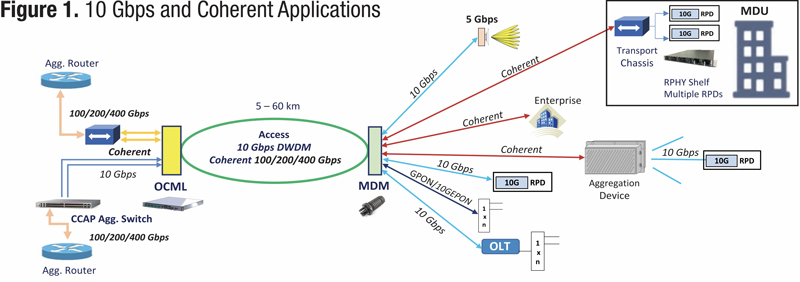OCML for Converged Access Networks
By Harj Ghuman and Jeff Finkelstein, Cox Communications
Cable networks are rapidly evolving from traditional analog to digital DWDM infrastructures that enable the adoption of distributed access architectures (DAA) such as remote PHY (R-PHY), remote MAC core (RMC), and remote MAC-PHY (R-MAC/PHY). These new distributed access technologies provide higher performance, lower overall optical costs and simplified network designs. An important feature of the converged interconnect network (CIN) — the network between the headend and remote devices — is the ability to have coexistence of 10 Gbps and 100 Gbps in the same network on the same fiber.
While coherent optics are ubiquitous in cable metro core and backbone optical networks, use cases are now being developed for coherent technology in the access domain. Available digital DWDM infrastructures can accommodate 10 Gbps NRZ DWDM associated with DAA as well as the introduction of coherent technology to address high bandwidth applications such as MDU and business services. Cox is developing an access network which can accommodate both conventional 10 Gbps NRZ DWDM and coherent optics, as well as carry both GPON and 10 Gbps EPON on the same fiber network. An added complexity is to support bi-directional transport of these signals on the same fiber and to provide fiber redundancy to the primary node area.
Converged Access Networks
This article describes a converged access solution (Figure 1) where several optical technologies may coexist on fiber using an innovative platform developed at Cox Communications called the optical communications module link extender (OCML pat. pend. — the ‘E’ is silent), which allows all the active elements such as EDFAs to be placed in indoor hub locations, keeping the outside plant transparent and passive. Passive optical networks, as well as 5G, can also be fed from the same optical backbone. The CIN may support several optical technologies and applications, resulting in a powerful, scalable and technology agnostic solution. This network can provide 10 Gbps for cable RPDs (remote PHY device) and RMDs (remote MAC device), 100 Gbps coherent for high capacity MDUs, PON (including next gen 100 Gbps PON) and 5G backhaul. Each fiber between the headend and the parent node (formerly analog HFC fiber node) may need to accommodate up to 20 RPDs/RMCs/RMDs. Sufficient wavelength capacity remains available with current filter structures to support 80 or more wavelengths. Each RPD/RMC/RMD can support many customers with 10 Gbps interconnections which provide ample capacity for growth. As 25 Gbps DWDM NRZ becomes available, the RPDs/RMCs/RMDs could be upgraded to 25 Gbps as required.
Meet The Optical Communications Module Link Extender
The OCML was developed at Cox Communications. It allows active components of a DWDM access network to be integrated into one module which can then be placed in the central office/headend/hub, while the outside plant aggregation point can be a simple WDM. The OCML supports next-generation fiber deep DWDM access networks and may transport up to 20 x 10 Gbps bi-directional wavelengths, plus future 100 Gbps coherent over variable 5 km to 60 km dual fiber links. PON/10 Gbps EPON signals may also be transported in the platform through an innovative WDM filter mechanism which passes through all wavelengths and blocks the 10 Gbps C band. As the industry begins to implement DAA rollouts, the OCML allows use of available 10 Gbps NRZ DWDM technology, but the underlying infrastructure is based on ITU standard wavelength plans in anticipation of the requirement to deploy 100 Gbps (and beyond) wavelengths.
Conclusion
Cox is planning for an access architecture which allows coexistence of bi-directional 10 Gbps NRZ and 100 Gbps coherent over the same fiber using an integrated platform (OCML). While the 10 Gbps transport is specified for 60 km, the coherent signals can be extended to 80 km. This will allow us to deploy a solution which is technology agnostic and support a multitude of services over the same network, fully utilizing existing fiber assets.

If you would like to hear more about the OCML, please contact the authors for details. Jeff.Finkelstein@cox.com or Harj.Ghuman@cox.com


